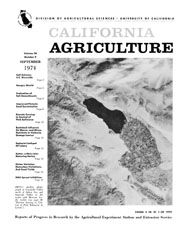


University of California
California Agriculture



|
|||
|
|||

Cover:
ERTS-I satellite photograph of Coachella Valley north of Salton Sea, and Imperial Valley to the south, with Mexican border visible (see “Remote Sensing in Control of Pink Bollworm in Cotton”).
September 1974
Volume 28, Number 9 News and opinion |
|||
|
University of California, 1301 S. 46th St., Bldg. 478 Richmond, CA
|